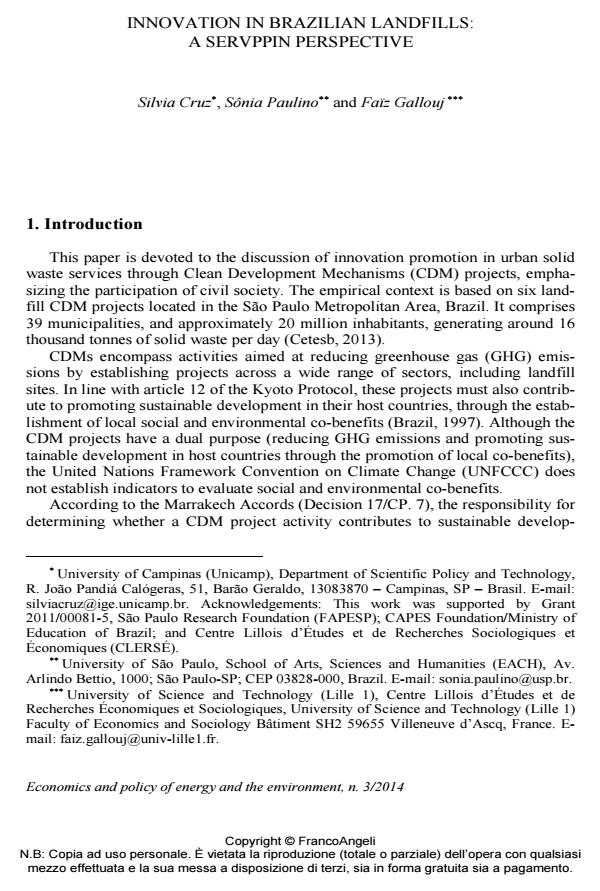Innovation in brazilian landfills: a servppin perspective
Journal title ECONOMICS AND POLICY OF ENERGY AND THE ENVIRONMENT
Author/s Silvia Cruz, Sonia Paulino, Faiz Gallouj
Publishing Year 2015 Issue 2014/3
Language English Pages 22 P. 79-100 File size 1172 KB
DOI 10.3280/EFE2014-003005
DOI is like a bar code for intellectual property: to have more infomation
click here
Below, you can see the article first page
If you want to buy this article in PDF format, you can do it, following the instructions to buy download credits

FrancoAngeli is member of Publishers International Linking Association, Inc (PILA), a not-for-profit association which run the CrossRef service enabling links to and from online scholarly content.
This paper is devoted to the discussion of innovation promotion in urban solid waste services through Clean Development Mechanisms (CDM) projects, emphasizing the participation of civil society. The empirical context is based on the municipal solid waste sector in Brazil, taking into account six landfill CDM projects located in the São Paulo Metropolitan Area. The discussion is based on the ServPPIN concept (public-private innovation networks in services). It focuses on the characterization of the landfills selected and on the identification of the stakeholders involved with these landfills, pointing out any participation gaps. The studied context confirms the centrality of multi-agent participation, addressed by the ServPPIN analytical approach, highlighting the wide involvement of several agents, and in particular, the issue of interaction with users. The results indicate that the participation of associations and cooperatives surrounding landfills is still marginal. Bringing this theoretical (ServPPIN) and empirical research (landfill CDM project) together, one can identify a relevant factor affecting the establishment of basic conditions for service innovation converging with the local co-benefits generation: a weak interaction with users.
Keywords: ServPPIN, innovation networks, innovation in public services, clean development mechanism, solid waste sector
Jel codes: Q560, Q540, Q530
- Unlocking the process of collaborative innovation - Combining mechanisms of divergence and convergence Chesney Callens, Koen Verhoest, in Public Management Review /2024 pp.1849
DOI: 10.1080/14719037.2023.2171096
Silvia Cruz, Sonia Paulino, Faiz Gallouj, Innovation in brazilian landfills: a servppin perspective in "ECONOMICS AND POLICY OF ENERGY AND THE ENVIRONMENT" 3/2014, pp 79-100, DOI: 10.3280/EFE2014-003005